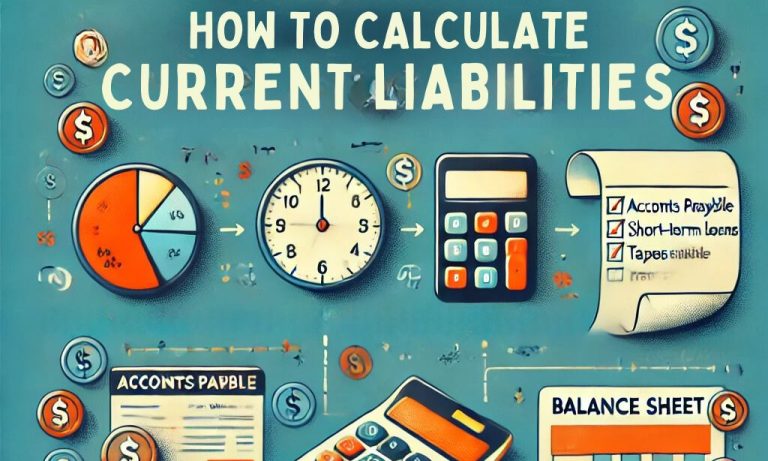Calculating current liabilities is of great importance to business owners, accountants, and finance students. Current liabilities are short-term financial obligations that a company must settle within one year or within its normal operating cycle. Calculating these liabilities accurately ensures businesses can settle their financial commitments and prevent liquidity problems. In this guide, we are going to explore what current liabilities are, the items included under them, the formula for calculation, and step-by-step methods for finding the value of current liabilities. Further, we will offer a calculation example and will answer some frequently asked questions.
What is Current Liabilities?
Current liabilities are the business’s financial obligations that are due and payable within the next 12 months or within the operating cycle of the business. These obligations are generally satisfied using the company’s current assets, such as cash, accounts receivable, or inventory. These consist of debts, payables, and other liabilities requiring quick payment to enable a company to continue operations without financial strain.
Businesses classify liabilities into either current or non-current based on when they are due. For instance, liabilities that are to be paid after 12 months are classified as non-current. This includes long-term loans or bonds. Conversely, items such as accounts payable, short-term loans, accrued expenses, and current portions of long-term debts fall in the category of current liabilities.
The ability to correctly and accurately calculate current liabilities enhances the management of working capital to make informed decisions. An instance where a company has excess amounts of current liabilities over current assets may suffer the problem of cash flow with a possibility of going through bankruptcy if not properly run. Proper calculation of current liabilities and understanding of proper management are the ways of maintaining financial stability.
Items Under Current Liabilities
Understanding the items that fall under current liabilities is essential for calculating them. The current liabilities section of a company’s balance sheet typically contains the key components.
Accounts Payable (AP)
Accounts payable is the amount the firm owes to suppliers as suppliers for goods or services acquired but not paid for yet. Usually, companies need to pay these short-term debts within 30, 60, or 90 days. The balance in accounts payable varies due to the purchases of a company and the payment terms from suppliers.
Short-term Loans and Borrowings
These are loans or credit facilities a company must pay back over the next 12 months. Short-term loans may be taken for different reasons, such as managing cash flow, financing working capital, or paying emergencies. Short-term borrowings often cost more than long-term borrowings because of the limited term of the repayments.
Accrued Expenses
Accrued expenses are costs incurred by the company that are not paid for. They might be salaries, wages, interest, taxes, and other operating expenses that accrue with time. Accrued expenses are recognized as liabilities in the balance sheet and settled when due.
Current Portion of Long-Term Debt
A company may have a long-term debt that will be repaid over many years, yet the amount of debt that will be paid in the next 12 months is considered a current liability. This enables creditors and investors to understand the immediate financial obligations that the company has to meet up with.
Taxes Payable
A company is liable to pay taxes payable to tax authorities but has not yet paid the amount. This may refer to income taxes, sales tax, or other government fees. Taxes payable are classified under current liabilities since they become due within a short period.
Dividends Payable
Dividends payable arise when a company declares dividends but has not yet paid them out to shareholders. It represents the company’s obligation to distribute profits to its shareholders.
Unearned Revenue
Unearned revenue refers to the money received by a company in advance for goods or services that it has yet to deliver. In this case, if a customer pays for a product before shipping, the amount must be recognized as unearned revenue, which would fall under current liabilities until the product is delivered.
Other Current Liabilities
Other current liabilities may include accrued liabilities, short-term provisions, or any other obligations that the company has to settle within a year. These liabilities are often specific to the nature of the business.
Current Liabilities Formula
To understand how to calculate current liabilities, it’s important to know the formula used to determine their total. The basic formula for calculating current liabilities is:
Current Liabilities = Accounts Payable + Short-term Debt + Accrued Expenses + Current Portion of Long-term Debt + Taxes Payable + Dividends Payable + Unearned Revenue
This formula includes all the major components of current liabilities. However, the company may include other liabilities as well, depending on its operations.
How to Calculate Current Liabilities
Now that we understand what a current liability is and the formula used to calculate such, let us take time to discuss the process by which one goes about doing the calculation of current liabilities. This process includes the identification of liabilities, summing them together, incorporating them into the balance sheet, and using them in their ratios.
Step 1: Identify Your Liabilities
First, one must identify all liabilities that will fall due within the next 12 months. The company’s accounts payable, short-term borrowings, accrued expenses, and other items like taxes payable and dividends payable must be looked at. One needs to check the balance sheet carefully to avoid missing any liabilities.
Step 2: Find the Sum of Your Liabilities
Once you have all your current liabilities identified, the next step is to sum them up. The sum will give you the total short-term obligations that your company owes. A company should pay the immediate financial obligations indicated by the sum within a year.
Step 3: Incorporate Current Liabilities into a Balance Sheet
The next step is to add this information to the company’s balance sheet after calculating the total current liabilities. The balance sheet has two main sections: assets and liabilities. Current liabilities should be reported separately from non-current liabilities to provide a clear picture of the company’s financial position to investors and creditors.
Step 4: Utilize Current Liabilities in Financial Ratios
Once you have the total figure of current liabilities, you can use it to calculate the important financial ratios, such as the current ratio and quick ratio, which will help you judge the liquidity of the company and its ability to pay short-term obligations. For instance:
- Current Ratio = Current Assets / Current Liabilities
- Quick Ratio = (Current Assets – Inventory) / Current Liabilities
These ratios provide valuable insights into a company’s financial health and its ability to handle its short-term debts.
Current Liabilities Example
Let’s walk through a practical example of calculating current liabilities. Suppose a company has the following liabilities on its balance sheet:
- Accounts Payable: $50,000
- Short-term Loans: $20,000
- Accrued Expenses: $10,000
- Current Portion of Long-term Debt: $5,000
- Taxes Payable: $7,000
- Unearned Revenue: $3,000
To calculate the total current liabilities, we simply add up these amounts:
Current Liabilities = $50,000 + $20,000 + $10,000 + $5,000 + $7,000 + $3,000
Current Liabilities = $95,000
This means the company has a total of $95,000 in short-term financial obligations. The company can now use this value to assess its liquidity using ratios like the current ratio or quick ratio, as discussed earlier.
How to Calculate Current Liabilities FAQs
What are the main components of current liabilities?
The main components of current liabilities include accounts payable, short-term loans, accrued expenses, current portion of long-term debt, taxes payable, dividends payable, and unearned revenue.
How do I calculate current liabilities in a balance sheet?
To calculate current liabilities in a balance sheet, identify all short-term obligations due within a year, sum them up, and list them separately under liabilities. Use the current liabilities formula to ensure accuracy.
What is the difference between current and non-current liabilities?
Current liabilities are obligations due within 12 months, while non-current liabilities are obligations due after 12 months, such as long-term debt or bonds payable.
What is the current ratio, and why is it important?
Calculate the current ratio as current assets divided by current liabilities. It measures a company’s ability to cover its short-term obligations with its short-term assets.
Can unearned revenue be considered a current liability?
Yes, unearned revenue is considered a current liability because it represents money received for goods or services that have not yet been delivered and should be settled within the year.


